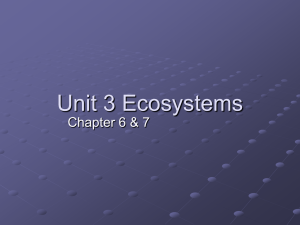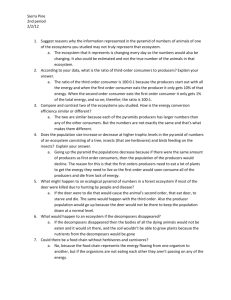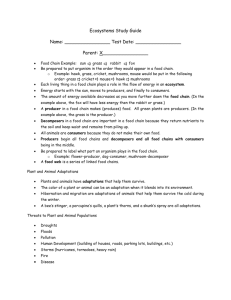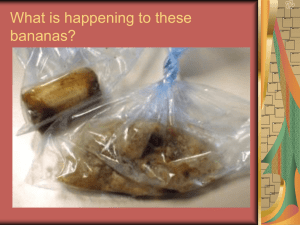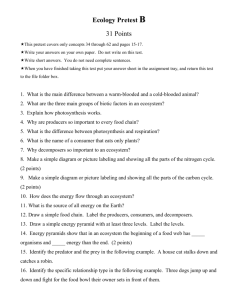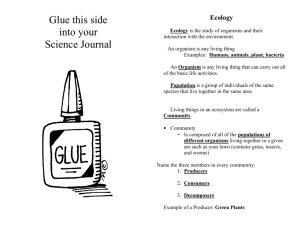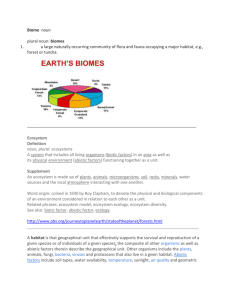Ecosystem Expeditions - North Carolina Botanical Garden
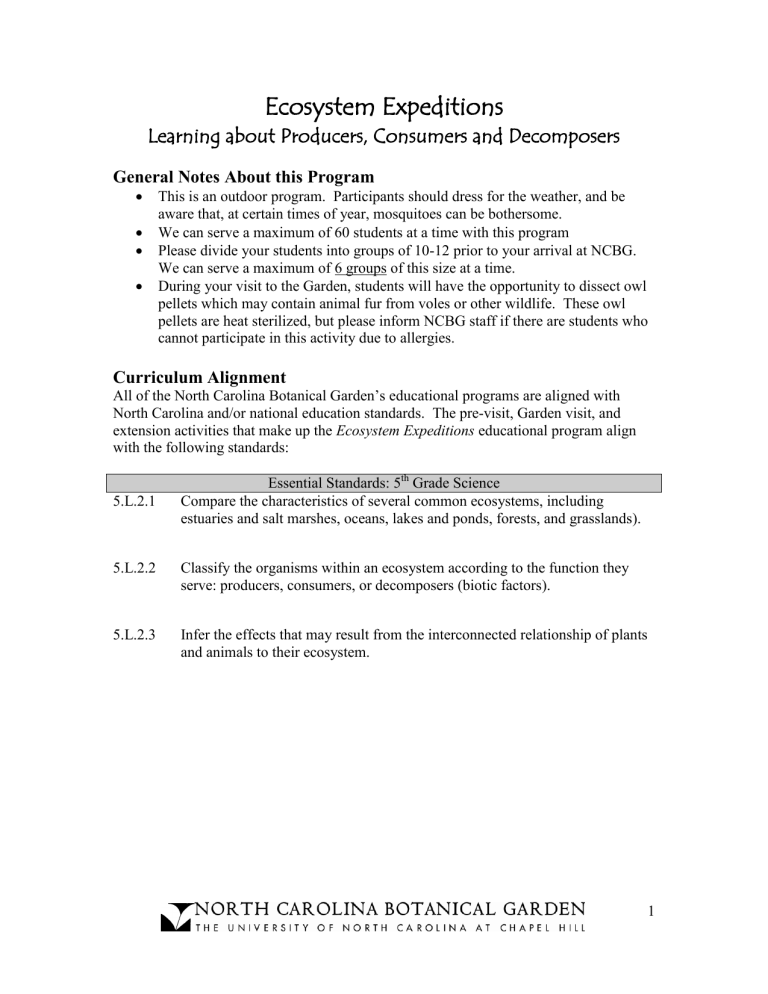
Ecosystem Expeditions
Learning about Producers, Consumers and Decomposers
General Notes About this Program
This is an outdoor program. Participants should dress for the weather, and be aware that, at certain times of year, mosquitoes can be bothersome.
We can serve a maximum of 60 students at a time with this program
Please divide your students into groups of 10-12 prior to your arrival at NCBG.
We can serve a maximum of 6 groups of this size at a time.
During your visit to the Garden, students will have the opportunity to dissect owl pellets which may contain animal fur from voles or other wildlife. These owl pellets are heat sterilized, but please inform NCBG staff if there are students who cannot participate in this activity due to allergies.
Curriculum Alignment
All of the North Carolina Botanical Garden’s educational programs are aligned with
North Carolina and/or national education standards. The pre-visit, Garden visit, and extension activities that make up the Ecosystem Expeditions educational program align with the following standards:
Essential Standards: 5 th
Grade Science
5.L.2.1 Compare the characteristics of several common ecosystems, including estuaries and salt marshes, oceans, lakes and ponds, forests, and grasslands).
5.L.2.2 Classify the organisms within an ecosystem according to the function they serve: producers, consumers, or decomposers (biotic factors).
5.L.2.3 Infer the effects that may result from the interconnected relationship of plants and animals to their ecosystem.
1
Ecosystem Expeditions
Pre-Visit Activity: The Perfect Match
Materials Needed:
5 copies of “The Perfect Match” worksheet (see below), with game pieces cut out
5 plastic zip-top bags
Procedure:
1.
Prior to the activity, cut out the labels (Producer, Consumer, Decomposer) and game pieces of 5 “The Perfect Match” Worksheets. Place the pieces of each worksheet in a separate zip-top plastic bag.
2.
Down the left side of the chalkboard, write the following words: Grass, Cow,
Human, Worm.
3.
On the right side of the board, write the following words: Producer, Consumer,
Decomposer.
4.
Ask the students how humans get their energy (from food). Ask them what we eat as food (plants and animals).
5.
Ask the students how a cow gets its energy (from food). Ask the students what a cow eats (grass and other plants).
6.
Ask the students how grass gets its energy (from the sun). Ask the students if grass and other plants need to “eat” other things, as humans and cows do.
7.
Ask the students how a worm gets its energy (from food). Ask students what worms eat (dead plants and animals that are in the soil).
8.
Ask the students if they can define any of the words written on the right side of the board. If they can’t define the words for them:
Producer: An organism (living thing) that gains energy from the sun to make its own food. Plants are producers.
Consumer: A living thing that gets its energy by eating other living things.
Animals including humans are consumers.
Decomposer: A living thing which feeds on material from dead plants and animals, and returns their nutrient to the soil.
9.
Ask students to help you match the words on the left of the board with the words on the right of the board (i.e. grass is a producer). As they state right answers, draw lines connecting the two words.
10.
Divide the students into 5 groups. Give each group the plastic bag with the game pieces in it. Instruct students to divide the game pieces into producers, consumers, and decomposers.
11.
Following the activity, have each group tell the class why they put a particular organism in a certain category. Do this until you have identified how each of the organisms on the game pieces gets its energy.
2
Ecosystem Expeditions
The Perfect Match
Cut out the game pieces below, and instruct students to group them by producers, consumers, and decomposers. **Note, they are grouped by producers, consumers and decomposers. Millipedes are decomposers, but centipedes are consumers.
Producers Consumers Decomposers
Millipede
3
Ecosystem Expeditions
Garden Visit: Ecosystem Expeditions
In this activity, Docents will lead an educational program at the North Carolina Botanical
Garden. Students will be led to different areas in the Display Gardens where they will learn about producers, consumers, and decomposers. Students will dissect and owl pellet, explore a wax myrtle leaf, and learn about decomposition.
4
Ecosystem Expeditions
Extension Activities: Bringing it Home
The North Carolina Botanical Garden encourages you to continue to teach students to appreciate nature by engaging them in hands-on, inquiry-based learning opportunities in the indoor and outdoor classrooms. The activities and books listed below are a good way to follow-up your garden visit while encouraging students to learn about and appreciate the natural world.
Classroom Activities:
Take your students outside, and have them write down the names of as many living things as they can. When they return to the classroom, have the students determine which things were producers, consumers, decomposers.
Have students choose a producer, consumer, and decomposer which depend on each other. Have students research, get pictures, and present to the class what they’ve found about those organisms.
Assign each student an organism which is a producer, consumer, or decomposer. Have students learn about how those organisms get their food/energy. Gather students in a circle with a ball of yarn. As each student tells the class what their assigned organism eats, use a length of yarn to make connections between organisms. The result will be a food web.
Have students research other environmental problems affecting our state. Students can present how these problems are affecting plants, animals, and humans.
Suggested Books:
Activity Guides for Teachers:
Starbuck, Sara, Marla Olthof and Karen Midden. Hollyhocks and Honeybees . St. Paul,
Minnesota, Redleaf Press, 2002.
Lachecki, Marina, Joseph Passineau, Ann Linnea, Ann and Paul Treuer. Teaching Kids to Love the Earth. Minneapolis, University of Minnesota Press, 1991.
See the following website for the Office of Environmental Education’s suggested books: http://www.eenorthcarolina.org/edresources/eebibbookselem.htm
Books for Students:
Batten, Mary. Aliens from Earth: When Animals and Plants Invade Other Ecosystems.
Atlanta, Georgia, Peachtree Press, 2003.
Cone, Molly. Come Back, Salmon.
San Francisco, Sierra Club Books for Children, 1992.
Johansson, Philip. The Temperate Forest: A Web of Life.
Berkeley Heights, New Jersey,
Enslow Publishers. 2004. (See other brooks from the A World of Biomes series from this publisher).
5
